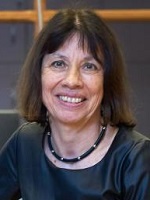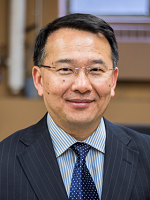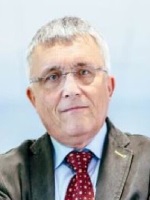Prof. Teresa Zielinska |
Short Bio: Full professor of technical sciences. Deputy director for research at the Institute of Aeronautics and Applied Mechanics of the Warsaw University of Technology (WUT) and Rector’s Proxy of WUT for internationalization and doctoral education. Member of the Control and Robotics Committee of the Polish Academy of Sciences, Vice-President of the Polish Section of Robotics and Automation IEEE (2016-2019) and Secretary General of the International Federation for the Promotion of Mechanism and Machine Science (IFToMM) (2011-2019). Local coordinator of the Japan-Europe Master of Advanced Robotics (JEMARO), member of the Experts Team of the Ministry of Science and Higher Education (2017-2018), member of the Council of the National Science Center (2019-2022). She conducted research at several international universities, e.g. Polytechnic University of Turin (grant from the Italian Ministry of Education), Loughborough University of Technology (UK, grant from the Science and Engineering Research Council), Nanyang Technological University (Singapore) - senior research fellow. Visiting professor at: National University of Singapore, Nanyang Technological University (Singapore), Griffith University (Australia), Keio University (Japan), Shanghai Jiaotong University (China), Tianjin University of Technology (China). She is the co-holder of 2 national patents and the author or co-author of over 300 publications. Teresa Zielińska received the award of the Minister of Higher Education (Poland) for her scientific monograph, the Gold Cross of Merit and the Medal of the National Education Commission, as well as many university awards for her scientific activity. She graduated from the Faculty of Electronics of the Warsaw University of Technology, specializing in control, received her doctorate in robotics, and obtained her habilitation at the Institute of Biocybernetics of the Polish Academy of Sciences. Her research interests concern robotics, in particular biorobotics. Teresa Zielinska deals with the design and implementation of real-time control systems, motion synthesis and the design of novel robotic systems inspired by biology. She designed a prototype of a shear force sensor, developed and implemented a model of a biological Central Pattern Generator to generate motion for a humanoid robot, implemented a control system for an autonomous team of biologically inspired autonomous walking machines. Currently, her research interests focus on predicting human movement and actions. She is a laureate of the 1000 Talents Experts Program of Tianjin Municipality. She serves as Vice President of HERITAGE Network (Europe-India, is a member of the advisory board of Chist-Era and coordinates of academic cooperation between WUT - NTU and NUS (Singapore).
Prof. Daolun Chen |
Short Bio: Dr. Daolun Chen is a Professor in the Department of Mechanical and Industrial Engineering, Toronto Metropolitan University, Canada. He received his BSc and MSc from Northeastern University (China), PhD from Institute of Metal Research, Chinese Academy of Sciences, and Dr.rer.nat. from the University of Vienna, Austria. Dr. Chen has published more than 480 refereed journal (396) and conference (90) papers in the area of advanced materials and key engineering materials, and their deformation, fatigue, fracture, welding and joining, plus over 230 non-refereed conference papers/research reports. His seminal work on nanocomposites leads to a well-known method that bears his name, and is twice identified by the Council of Canadian Academies to be one of the top 1% most highly cited papers in his field worldwide. He has also been featured in the World's Top 2% Scientists List in a study from Stanford University, California, USA. Dr. Chen is a recipient of numerous prestigious awards including Premier's Research Excellence Award, G.H. Duggan Medal, Canadian Metal Physics Award, MetSoc Award for Research Excellence, MetSoc Distinguished Materials Scientist Award, Sarwan Sahota Distinguished Scholar Award, Ontario Professional Engineers Awards (OPEA) Engineering Medal - Research and Development. Dr. Chen is an Associate Editor or Editorial Board Member of 28 journals, including Journal of Magnesium and Alloys, Journal of Materials Science and Technology, Materials and Design, Materials Research Letters, Materials Science and Engineering A, International Journal of Fatigue, etc. He has been invited by science reporters to give interviews and comments on some key scientific breakthroughs published in the journals of Nature and Science. Dr. Chen is an elected Fellow of Canadian Academy of Engineering (FCAE), Member of European Academy of Sciences and Arts (MEASA), Fellow of Canadian Institute of Mining, Metallurgy and Petroleum (FCIM), Fellow of Canadian Society for Mechanical Engineering (FCSME), Fellow of CWB (Canadian Welding Bureau) Association (FCWBA), Fellow of Institute of Materials, Minerals and Mining (FIMMM). More information could be seen on his web site at https://people.ryerson.ca/dchen/biography.html.
Prof. Wojciech Grega |
Short Bio: Wojciech Grega received his PhD degree in Automatic Control (1979), degree of Doctor of Science (DSc) in Automatics and Robotics (1994). Professor's title he received in 2005 from the President of Republic of Poland. Full Professor of AGH in Krakow: digital control, optimization methods, distributed control, industrial control systems, engineering education. He held various visiting appointments: at Montreal University in Canada (1990), City University in London (1992), and positions of visiting professor in ESSTIN, Nancy, Lyon, (1996) and Embry Riddle University, Daytona Beach, USA (2000). Currently also serving as Supervisory Board Member and scientific consultant for several Polish innovative company. He is author and co-author of more than 150 papers and 3 books. He has been coordinator or main researcher in 22 national and international projects (lately: Horizon 2020: KIC-ASS, ProInterface, EACEA: ILERT, DESIRE). Served as a member of several scientific committees, including Commission of Technical Sciences of the Polish Academy of Arts and Sciences (2004 - 2010). He was Vice Dean of the Faculty (AGH, 1994-97); Head of the Control Laboratory at Department of Automatics and Biomedical Engineering of AGH (since 2002), Head of the Chair of Applied Computer Science in the Malopolska Higher Vocational School in Krakow (2009-2011), Executive Board Member of the European Association for Education in Electrical and Information Engineering (since 2005), KIC InnoEnergy Poland+ Educational Director (2011-15), co-editor of Measurement Automation and Monitoring Journal (PAR) and International Journal of Modeling and Optimization. In 2016-2017 and since 2018 he has been elected chairman of IEEE Control Systems Society, Polish Section. Currently, he is serving as Supervisory Board Member and/or Scientific Consultant for several Polish innovative company (http://www.inteco.com.pl/, http://www.jes-energia.pl/en/ ). He was chairman and co-founder of several international conferences, between them Federated Conference on Computer Science and Information Systems (2011-2017). Invited plenary lecturer at prestigious international conferences, like Meeting of the Directors General of Higher Education, Dublin 2013, ERA in Action: Excellence and cohesion, Brussels 2013.



